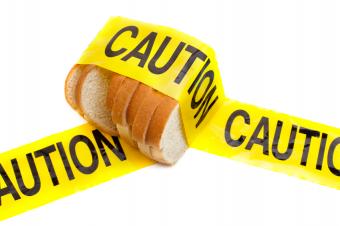
If you or a loved one has recently been diagnosed with celiac disease, you probably feel overwhelmed and confused about how to start living gluten-free. Getting used to a gluten-free lifestyle will take some time and you are likely to have a lot of questions. Here are some answers.
Living Gluten-Free - The First Five Things to Do
It may be hard to believe, but you will eventually get used to being on a gluten-free diet. Right now, though, you probably are questioning whether every bit of food you put into your mouth is safe. Take away some of the stress by following these five steps as soon as you can after you are diagnosed:
1. Buy Food You Can Eat
If you don't have safe food to eat, you will not be able to begin healing. You will also be less likely to cheat on your new diet if you have food you like to eat available whenever hunger strikes. Many foods are naturally gluten-free and available in any grocery store, such as:
- Fresh fruits and vegetables
- Potatoes, beans, rice and corn
- Red meat, poultry, fish and shellfish
- Many dairy products including most cheese, yogurt and milk
- Nuts and oils
Today, almost every grocery chain also carries at least a few packaged gluten-free foods, such as cookies, chips, pasta and baking mixes. National chains with particularly good gluten-free offerings include:
It may take some time to find which brands and items you like the best, so be prepared to "taste test" a lot of products at the beginning.
2. Clean Your Kitchen
Whether you decide to make your entire house gluten-free or to keep both gluten and non-gluten foods in it, you need to have a safe place to store and prepare your gluten-free meals. If you do still have gluten-containing foods in your kitchen, you need to take extra steps to avoid cross-contamination.
Here are some of the things you need to do to make your kitchen safe to prepare gluten-free food:
- Wipe down all cabinets and shelves that will hold gluten-free food.
- Clean counters and appliances well to eliminate crumbs.
- Buy a new toaster oven (it is impossible to completely clean them of crumbs), and only use it for gluten-free foods.
- Buy new "gluten-free only" wooden spoons, plastic mixing bowls and non-stick pans.
- Run all metal and glass dishes and utensils through a hot dishwasher (or wash by hand) between gluten and non-gluten meals.
- Buy new jelly, peanut butter, butter, cream cheese and any other condiment or food item that could become contaminated by gluten crumbs. You will need separate, labeled versions of these items if you plan to keep gluten in your house.
- Replace gluten-free baking items such as sugar, baking powder and baking soda that could have been contaminated during gluten baking projects.
- Buy new sponges for washing dishes and keep sponges used for gluten separate.
- Teach your family the "rules" for keeping gluten and non-gluten foods separate.
3. Find a Resource
You are likely to have a lot of questions in the first few months after you get diagnosed. Fortunately, there are plenty of reliable and helpful resources available to help new celiac patients navigate the gluten-free lifestyle.
Ask around and do some research to find lists of gluten-free foods and products, information about shopping, cooking, travel and eating out, and even friends with celiac disease who can answer your questions. There are also dozens of online resources, bulletin boards and chat rooms about living gluten-free that you may find helpful as well.
4. Search for Replacement Recipes
You don't have to give up your favorite home-made treats when you go gluten-free; you should be able to find replacement recipes for nearly everything you crave. In fact, you can easily find delicious recipes for gluten free-baked goods including:
Magazines such as Gluten Free and More and the cookbook section of your local bookstore are filled with gluten-free recipes for all kinds of meals, many of which taste just like their gluten-filled counterparts.
5. Get Retested
You will hopefully start to feel better soon after going on a gluten-free diet. To make sure that you are healing internally, it is important to see your internist or gastroenterologist for a follow-up visit after you are diagnosed. Your doctor should retest your blood for the antibodies associated with celiac disease to make sure that the numbers are dropping. Having antibody levels in the normal range is the best way to know that you are being successful on your gluten-free diet.
You Can Do It!
Changing to a gluten-free diet will be an adjustment, but your health is worth it. It may seem overwhelming at first, but before too long, being gluten-free will feel like second nature.







